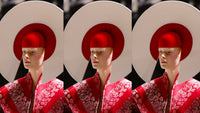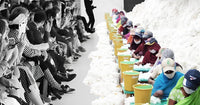FASHION BEGINS WITH FABRIC
A SHORT OVERVIEW OF DIFFERENT MAN-MADE TEXTILES DURING THE 20TH CENTURY
In the 1960s a new question was raised: Do we really need new fibers?
YES – what kind?
NO- why not?
The textile industry's evolution has been shaped by technological advancements and shifting consumer preferences. From its early manual practices to the introduction of mechanization during the Industrial Revolution, significant inventions such as the spinning jennies and the power loom have revolutionized production methods. The cotton gin's invention played a pivotal role in the industry's expansion. Globalization further accelerated production in regions with lower labor costs.
In today's world, the concept of sustainability continues to drive changes in production and materials. The industry has faced challenges, initially related to environmental impact and later concerning labor practices. Ongoing improvements and innovation will be necessary to address these issues. However, in the past, questions about sustainability were often overshadowed by consumerism and the pressure to meet trends. Nonetheless, this period also gave rise to some of the most impactful fabrics. Let's poke into some of these innovative materials.
*Spinning Jennies or Spinning Jenny (jenny aka engine) is a spinning machine invented during Industrial Revolution for spinning yarns and multiple threads.
* Power loom is an electric loom machine used to make fabric from yarns.
*cotton gin (cotton engine) is a machine that separates cotton fibers from the seed faster.
JERSEY
Jersey fabric can be made from cotton, wool and synthetic fibers.
The history of jersey fabric is closely linked to the advancement of knitting and textile manufacturing techniques. Coco Chanel's innovative use of jersey fabric in her designs transformed the way people viewed and valued this material.

Chanel was the first designer to use jersey, which at the time was reserved for men's underwear. Jersey was simple, practical and comfortable. Her choice of this material was a necessity, because the war had resulted in a short supply of expensive fabric




(1st) KNIT VY WAMSUTTA Flocked Matte Jersey- A blend of 90% acetate 10% nylon
(2nd ) KNIT BY SOPTRA A soft matte jersey- A 100% Trevira polyester
(3rd) FABRIC BY SWIFT MILLS Checkered Blend 50% polyester 50% cotton blend
(4th)FABRIC BY HORIZON FABRICS All-Purpose Blend - 75% rayon and 25% nylon, an all purpose cloth used for pants, shirt, dresses - in both solids and prints




(1st) KNIT BY STEVCOKNIT Tweedy Knit - A doubleknit of 100% cotton
(2nd) KNIT BY BLENDS, Inc The subtle Doubleknit - 100% textured ployester has a very subtle texture
(3nd) KNIT BY B & E MILLS Vintage Jacquard - A 100% polyester fabric
(4th ) FABRIC BY WAMASUTTA Sculptured Corduroy - universal fabric 100% cotton
In 1960, the production of silk was a labor-intensive process that followed traditional methods. This involved feeding silkworms mulberry leaves, harvesting cocoons, softening the cocoons, manually extracting silk threads, spinning and weaving, and finishing the fabric.

The replication of silk production techniques by humans was a groundbreaking development as it effectively put an end to China's monopoly on silk and encouraged cultural exchange.

FABRIC BY COLLINS & AIKMAN
Flat Fur of Rayon
Called “Veil- Tail”
This fabric is 100% rayon with a 100% cotton back used for coats, jackets, slacks, skirts, vests and millinery for woman; linings for coats and jackets.

FABRIC BY COHAMA
100 % rayon Sculptured Velvet Animal Skin
 FABRIC BY COHAMA
FABRIC BY COHAMA
96% rayon/ 4% Lurex – a mystery combination
 KNIT BY ALAMAC & MILLS
KNIT BY ALAMAC & MILLS
Buttery Suede
A knitted blend of 93% Orlon 7% nylon, this fabric might be called The Unlimited Suede. Used for tops, pants, dresses, etc

FABRIC BY AVILA
A Silky Look that breathes
A 100% nylon ciré fabric , which gives a new dimension to slink.
Silky, durable, lightweight.
used for bathing suits, blouses, jackets and pants.

FABRIC BY SOPTRA
Flannel to Shape and Drape
70% Trevira 30% rayon used in suits, dresses and sportswear.
The Bold New World Of Denim





1) The original classic blue denim
2) Hickory Stripes (firstly made for carpenter overalls)
3) Fisher Stripe (originally made for workers at the fisher auto body plant)
4)Palmer Stripe (originally for longshore overalls)
5) Expandra ( Strech denim for Sportswear)
The term "denim" is said to have originated from the French expression "serge de Nîmes," which refers to a strong fabric from the town of Nîmes in France. This fabric closely resembled what we now know as denim. Soldiers from Genoa, Italy, often referred to as "jeans" by the French, popularized the pants, giving rise to the nickname. Originally, denim was used as workwear due to its durability. It gained popularity among laborers, miners, and farmers in the 18th and 19th centuries for its strength and resilience.
The modern history of denim is closely associated with Levi Strauss, who popularized it during the late 19th and early 20th centuries. They were commonly worn by cowboys, miners, and workers.
The widespread popularity of jeans expanded when Hollywood stars like James Dean and Marlon Brando started wearing them on-screen in the 1950s. This contributed to the association of denim with rebellion and youthful nonconformity.
In the 1960s and 1970s, jeans became a part of the counterculture movement, embraced by hippies and youth seeking to reject traditional norms, making jeans a symbol of anti-establishment ideals. By the late 20th century, denim had firmly established itself as a global fashion staple, transcending age, gender, and socioeconomic boundaries.
In recent years, there has been an increased focus on sustainable denim production due to concerns about water usage, chemical pollution, and labor conditions in the denim industry.
From its humble beginnings as sturdy work pants to its present-day status as a fashion statement, denim's journey through history is a testament to its enduring appeal and adaptability.


(1st) Miners in jeans in the 1870
(2nd ) James Dean in 1960







